The AMD Llano Notebook Review: Competing in the Mobile Market
by Jarred Walton & Anand Lal Shimpi on June 14, 2011 12:01 AM ESTApplications, Round Two: Treading Water
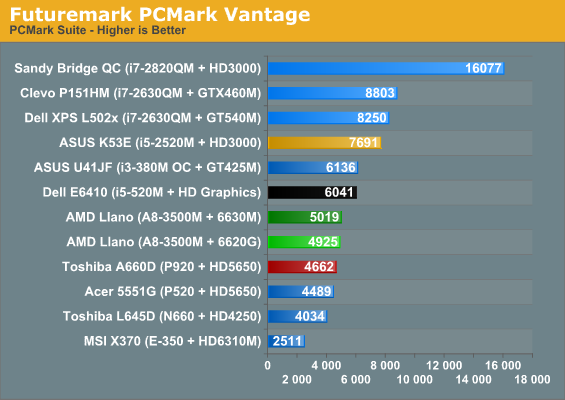
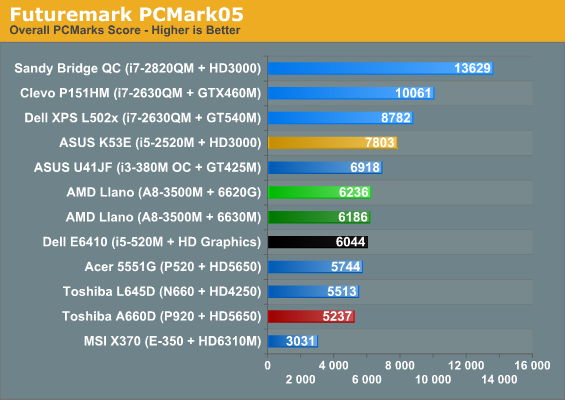
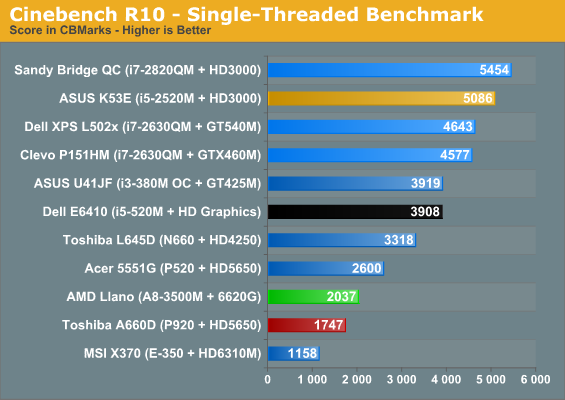

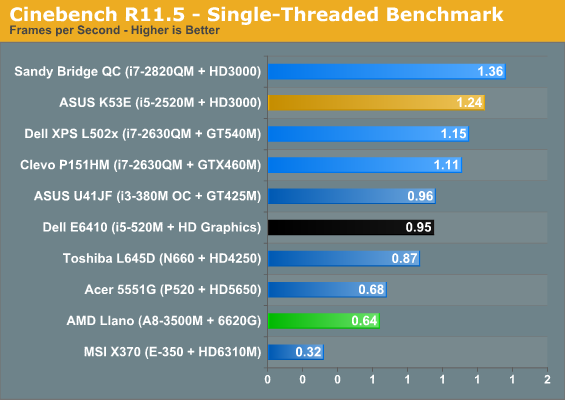
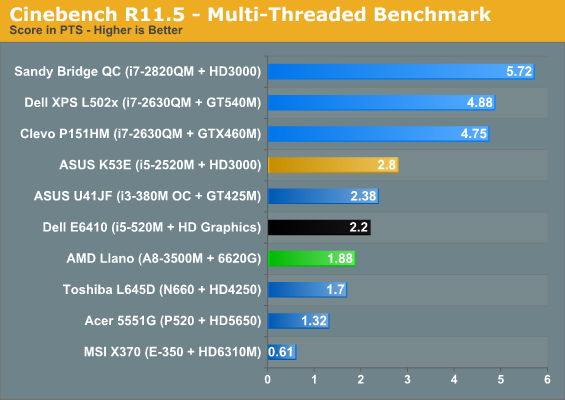
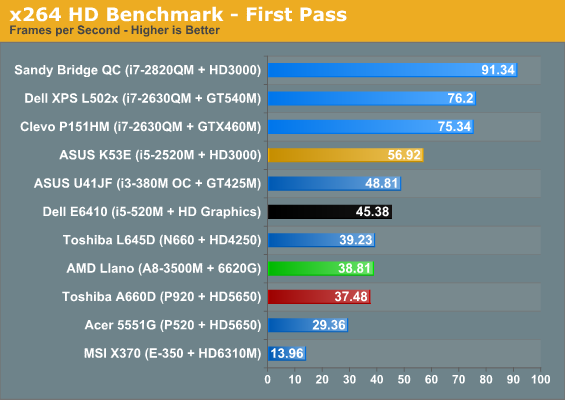
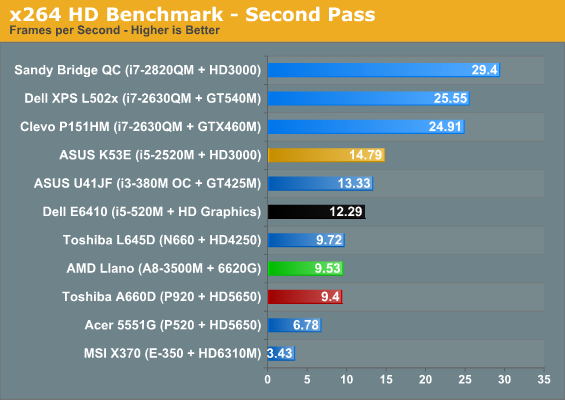
This time we have a more interesting competitor to look at: the Toshiba A660D. AMD says Turbo Core works at speeds of up to 2.4GHz on the A8-3500M, but we have no way of monitoring the actual CPU clocks right now. (CPU-Z if you’re wondering shows a constant 1.5GHz, but AMD says that utility doesn’t currently detect the proper clocks.) When we compare performance results between the Llano notebook and the A660D, we definitely see some differences in performance. Some of that may come from the added L2 cache and other architectural tweaks, but Cinebench R10 in particular shows a healthy 17% performance increase, even with a base clock that’s 7% lower. In the multi-threaded Cinebench result, the lead drops to 10%, which correlates well with how we’d expect Turbo Core to work. PCMark Vantage is still heavily influenced by the storage subsystem, and the storage score of 2950 on the A660D versus 3791 on the Llano suggests the Toshiba HDD is a significant bottleneck.
Looking at other laptops and tests where we’re looking purely at CPU performance, suddenly Llano starts to struggle. The Arrandale i5-520M offers 92% higher single-threaded performance in Cinebench R10 and 48% better single-threaded performance in R11.5; multi-threaded performance also goes to Arrandale, with a 23% lead in R10 and 17% lead in R11.5. x264 also gives Arrandale a decent lead, with i5-520M 17% faster in the first pass and 29% faster in the more intense second pass. The overclocked i3-380M in ASUS’ U41JF tells a similar tale—and both of these laptops are running processors from early last year. When we shift to Sandy Bridge, even without looking at the quad-core parts AMD’s CPU performance is tenuous. The i5-2520M is anywhere from 50 to 150 percent faster depending on which test we look at; even if we toss out the older Cinebench R10 single-threaded result of 150%, R11.5 given the 2520M a 94% lead. In general, then, a moderate dual-core Sandy Bridge i5-series processor looks to be at least 30% faster, so quad-core Llano really only competes with Core i3 and its lower, non-Turbo clocks.
None of the results here are particularly surprising; K10.5 even at 32nm is still largely the same performance. AMD has focused this round up upgrades more on reducing power consumption rather than increasing performance, and that’s a perfectly reasonable approach for a mobile CPU. Most of us probably aren’t doing 3D rendering, CAD/CAM, or unassisted video transcoding on our laptops anyway. It would still be great to see AMD offer up an equivalent to Intel’s Quick Sync; they have the better GPU architecture, but a dedicated decoder like Quick Sync can clearly pay dividends. Outside of that one deficit the reality is that Llano is still plenty fast. Slapping an SSD into Llano will make more of a difference than upgrading an HDD-based Llano laptop to Core i5, so if you’re looking for an inexpensive laptop that can do everything most users need, Llano is very appealing.










177 Comments
View All Comments
DanNeely - Tuesday, June 14, 2011 - link
Just looking at transistor count misses most of the story. The highly repetitive layout in the GPU allows for much denser transistor layout, the die is only 5% larger. That's close enough that factors like yield and raw per wafer cost become at least as important.Lunyone - Tuesday, June 14, 2011 - link
Looks like we're finally getting close to having integrated graphics good enough for some good light gaming :) Hopefully these won't be priced to high to sell. There are sooo many Sandy Bridge based laptops out there that are within the $500-600 price range it isn't even funny. I hope we can get the top of the line Llano for about $600-650. I think the C50 or E-350 have been relegated down to tablet only now, since Llano is where it's at now.ET - Tuesday, June 14, 2011 - link
Brazos will likely keep its place at the lower price point and smaller size laptops. It would be interesting to see if the larger E-350 laptops will be replaced by Llano or will survive. I was surprised they were even introduced, but it's possible that if people are buying them they will continue to do so.Still, I'm hoping that Llano can make it into small form factor laptops.
Beenthere - Tuesday, June 14, 2011 - link
I am definitely ready to buy a Llano powered laptop. I suspect Llano will suit the needs of the largest notebook segment and deliver better graphics at a lower price point. AMD is bound to take notebook market share from Intel. I wouldn't ever consider an Intel product.RussianSensation - Tuesday, June 14, 2011 - link
What? The largest notebook segment doesn't care about GPUs in a laptop. Look at Apple - a non-gaming platform more or less - and quarter after quarter has the highest growth in the notebook market share. The fact that Intel HD graphics command #1 market share in the mobile and desktop space also shows that the the majority of consumers don't care about mobile graphics beyond watching HD content.So with Llano you get a GPU that's still only fast enough for 1368x768 resolution gaming at the lowest settings and CPU performance that's only as fast as a Q6700 from 2007. Llano only makes sense if you are on a budget to buy a laptop. If you care about CPU performance, it's too slow. If you care about GPU performance, it's again too slow. So the only customer it will find is a niche one until they can create an APU with Bulldozer cores inside and a much faster GPU.
We have also seen a significant surge in consumers that desire premium made notebooks. Llano designs will likely be relegated to cheap looking and cheap quality laptops. Certainly it wont be able to compete with Ultrabooks.
I am almost certain that most of today's consumers will care about screen resolution, an SSD, the quality of the screen/materials build quality of the laptop before even thinking about the fact that Llano's GPU is faster than Intel's. Then there is AMD's past history of having unimpressive mobile CPUs over the last 5+ years. It's going to take 2-3 generations before consumers even think about switching brands in such a scenario. Most people will just buy an Intel based SB notebook simply because Intel has made the best mobile processor for the last "forever".
This is a good step for AMD, but they have a long road ahead.
duploxxx - Tuesday, June 14, 2011 - link
The share count is no longer relevant since an IGP is deployed anyhow with each system, while there are many delivered with discrete it still counts as an IGP also.Have a look at your so called apple highest growth market... it ships with discrete ATI graphics.....
Actually most don't know that the IGP is crappy, they are fooled by adiot sales and large electronic vendors who try to push there margins.
THis is the introduction generation that will shed some light, just look at the brazos also, it has been a success and even atom refresh wil not be able to take this back.
nickb64 - Tuesday, June 14, 2011 - link
arguably the most popular Apple laptop, the 13" Pro, now ships with Intel Integrated graphics, not discrete ATI/AMD graphicsOverall, you're right, but I just wanted to point out that Intel is probably getting a pretty solid boost out of 13" MBP sales this year.
jjj - Tuesday, June 14, 2011 - link
lol that's quite something to give Apple as an example for what the average user needs.Macs are niche products and will remain so without fundamental strategy changes.ps:how outraged would you be if tomorrow the new Air shows up with a Llano in it?
pps:today's average consumer makes a few hundreds $ per month and is not looking for high resolution (not that he knows wtf resolution is anyway) or SSD.
RussianSensation - Tuesday, June 14, 2011 - link
Intel wouldn't ship Air with Llano, not until they can deliver Bulldozer cores. Why would they ship a laptop with 50% slower CPU speed and go backwards? Not to mention, they'd lose Thunderbolt if they ditched SB.mino - Tuesday, June 14, 2011 - link
Thunderbolt is PCIe.